A brief history of Astronomy

Countless generations have looked up at the night sky to observe its twinkling stars and dancing lights. In dark and remote places, before the advent of today’s modern metropolises, the shimmering night sky must have looked truly alive.
Early days (and nights)
Indigenous cultures around the world have long performed astronomical observation with the naked eye, frequently spotting stars, planets, and other celestial phenomena.
These communities often used their knowledge of astronomy for:
- Navigation
- Timekeeping
- Agricultural planning
- Spiritual and religious practices
A closer look at the heavens
Ancient astronomers from around the world made many early observations and predictions. Historical records include many star charts, which reveal clear efforts to map the night sky and learn more about the mechanics of our universe.
Some examples of early discoveries include:
Planets versus stars
Babylonian astronomers in the first and second millennia BCE tracked five points of light in the night sky that moved differently than the other stars did. They concluded that something fundamentally different existed: these five points of light were not stars at all. Historians and astronomers now believe the Babylonians were among the first to recognize the planets Mercury, Venus, Mars, Jupiter, and Saturn, which become visible to the naked eye at different times of the year.
Aspherical Earth
As early as the 6th century BCE, ancient Greek philosophers documented evidence that Earth was a sphere. They noted that the night sky looked different when seen from various locations on Earth, hinting at our planet’s curved surface. They also observed the round shadow of Earth on the Moon during lunar eclipses. These philosophers were even able to calculate the circumference of Earth quite accurately. They did this by measuring the length of the shadow cast by an object at exactly the same time, in two different locations. Taking into account the distance between those two locations and the difference in the lengths of the shadows, they calculated that Earth’s circumference was about 46,250 kilometers. That is very close to the real value of 40,075 kilometers!
Bright supernovae
In the year 185, Chinese astronomers became the first to document a supernova. Several supernova explosions have been observed since then, including a particularly bright one in the year 1054, which (at its peak) was four times brighter than planet Venus, one of the brightest objects in the night sky. Some supernovae are even bright enough to be visible during the day!
Cloudy galaxies
The notion that our own galaxy – the Milky Way – is but one of trillions of other galaxies in the universe only dates back about a century. Before then, nearby galaxies were thought to be cloudy regions of the Milky Way. The first documented observation of the neighbouring Andromeda Galaxy was in the year 964 by a Persian astronomer who described it as a “nebulous smear.” For centuries, it was simply known in star charts as the “Little Cloud.”

The astrolabe, such as this one developed in 1553 by French clockmaker Jean Naze, is a navigational tool that can determine local time and location in latitude based on the position of celestial objects. Although the Sun is most commonly used, a total of 58 recognized “navigational stars” can help calculate the user’s location. One method of astronavigation even uses the angle of the Moon to calculate time, a key piece of information for pre-modern sailors travelling on unfamiliar seas. (Credit: Marie-Lan Nguyen)
The Copernican revolution
Before the 16th century, Earth was commonly thought to be at the centre of the solar system, with all other celestial objects revolving around it. This is known as the geocentric model. This theory, however, did not match some confusing observations made by astronomers, such as the path of planets that appeared to move backward on their orbits.![]()
When we observe, from Earth, the planets around the Sun, they do not always appear to be moving in one direction in our sky. Sometimes they appear to loop backward for short periods of time. This is called retrograde motion and is one of the key pieces of evidence that the Sun lies at the centre of the solar system and all the planets revolve around it.
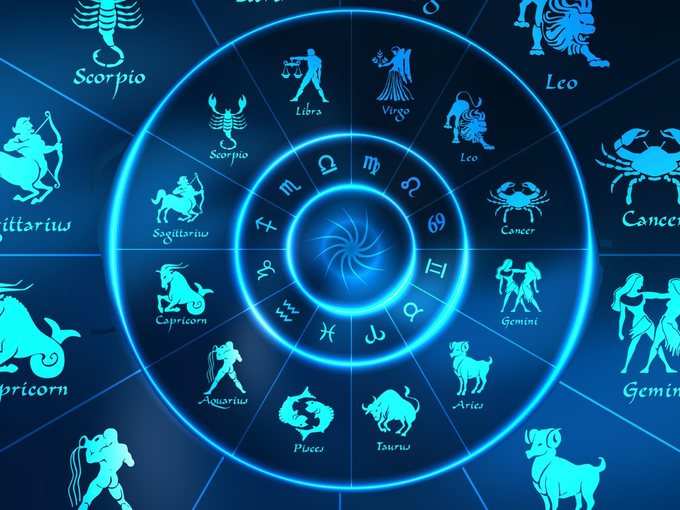
In 1543, Polish astronomer Nicolaus Copernicus proposed a heliocentric model of the solar system in which the planets orbit the Sun. This model explained the unusual path of planets that astronomers had observed. The new theory was one of many revolutionary ideas about astronomy that emerged during the Renaissance period.
The work of astronomers Tycho Brahe and Johannes Kepler led to an accurate description of planetary motions and laid the foundation for Isaac Newton’s theory of gravitation. This progress dramatically improved humanity’s understanding of the universe. Their observations and investigations were strengthened by the invention of the telescope in the early 17th century. Italian astronomer Galileo Galilei popularized the use of telescopes to study and discover celestial objects, including Jupiter‘s four biggest moons. In his honour, they are known as the Galilean moons.
An expanding universe of knowledge
Over the following centuries, astronomers around the world formalized the study of the sky by creating detailed catalogues of stars, star clusters, and nebulae. After discovering Uranus in 1781, William Herschel opened new areas of research in 1800 by discovering infrared radiation – a type of light that is not visible to the human eye.
Others took advantage of rapid progress in the fields of optics and imaging. In 1923, Edwin Hubble fundamentally changed the scientific view of the universe when he used the 2.5 m-diameter Hooker telescope to prove that the Andromeda Nebula extends beyond our Milky Way Galaxy.
Hubble’s discovery of the universe’s ongoing expansion also paved the way for other astronomers to theorize its origin. The big bang theory, first proposed by Georges Lemaître, was later bolstered by strong evidence: the discovery of the cosmic microwave background (CMB), faint “noise
” left over from the massive explosion that gave rise to everything in the universe. The CMB was accidentally discovered by radio astronomers just five years before the 1969 Apollo 11 Moon landing.
Improvements in satellite launch and design allowed astronomers to collect even more data about planets within our solar system in the second half of the 20th century. Several robotic space probe campaigns, including Mariner, Venera, and Voyager, ventured farther than ever before.
Astronomy today
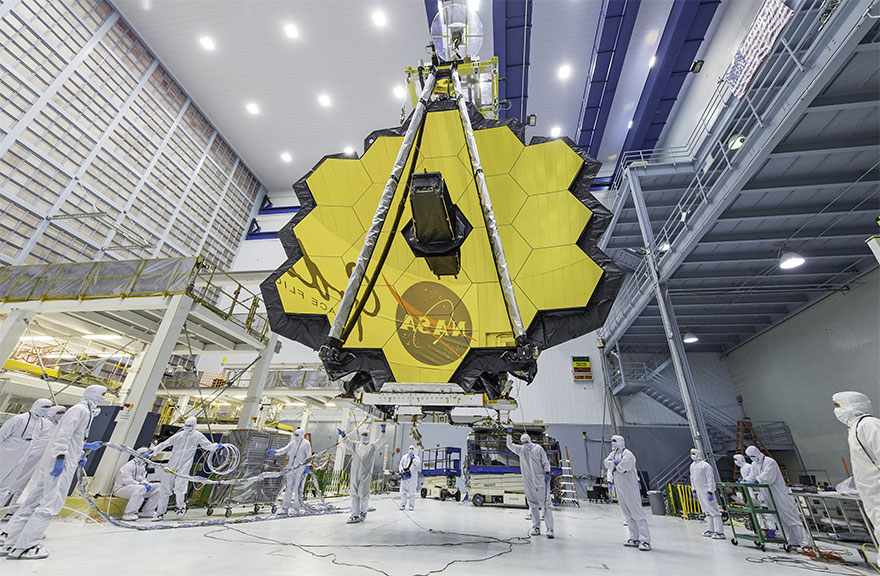
Today, astronomers collect data about celestial objects by using huge telescopes on the ground as well as in space. These modern telescopes equipped with massive mirrors allow astronomers to capture the light of very faint and faraway objects. Specialized techniques and sensitive scientific instruments have been developed to study not only visible light but also the entire electromagnetic spectrum of light including infrared light, radio waves and X-rays.
Large, complex telescopes and advanced techniques have even enabled astronomers to directly observe phenomena including black holes, distant exoplanets, and gravitational waves.
Thanks to the sheer size of its 6.5-metre-diametre golden mirror, the James Webb Space Telescope is the largest space telescope ever built. Set to launch in 2021, Webb will use its precision instruments to peer into clouds of cosmic dust to collect infrared light from distant stars and galaxies, giving Canadian astronomers a groundbreaking glimpse of the earliest moments of our universe and never-before-seen planets circling other stars.
Explore further
https://www.asc-csa.gc.ca/eng/astronomy/basics/brief-history-astronomy.asp
——————————————————————————————————————–
Why astronomy is considered the oldest science
Initially a cosmic curiosity, the night sky was eventually decoded by ancient peoples, making astronomy one of (if not the) oldest science. By Eric Betz | Published: Tuesday, October 6, 2020RELATED TOPICS: PLANETARY SCIENCE
This roughly 2,800-year-old Babylonian tablet shows priests at the shrine of the Sun-Temple at Sippar, home to a Sun-worshiping cult. In the field above the Sun God, you can see the Sun and Moon, as well as an eight-pointed star, each a symbol of an ancient deity. Below their feet is the “heavenly ocean.”The Trustees of the British Museum
Millions of years ago, ancient humans living on the African savanna likely gazed up in wonderment at the bright Moon and star-filled sky. This cosmic backdrop wasn’t too different from the one we see today; but how they interacted with it almost assuredly was. It wasn’t until humans came to view the stars as tools that we became masters at understanding their movements.
By some 7,000 years ago, a group of nomadic people living on the African savanna became the first-known humans to record the motions of the stars at a site called Nabta Playa. This cattle-worshiping cult of hunters and gatherers built the world’s oldest stone circle to track the arrival of the summer solstice, as well as the seasonal monsoons they depended on for water and food.
“This was the dawn of observational astronomy,” J. McKim Malville, a professor emeritus at the University of Colorado and archaeoastronomy expert, told Astronomy earlier this year.
It would be millennia before such rigorous observations were applied to other fields like biology, chemistry, geology, medicine and more.
The origins of astronomy
Thousands of years after the construction of Nabta Playa, similar moments would play out all around the world. Our species was evolving from stargazers to scientists.
Astronomy ultimately emerged in China, India, Egypt, Europe, Meso-America, and the Middle East. Developing an intimate knowledge of the stars proved essential to running a complex agricultural society.
Sure, ancient humans still projected their myths and gods into the heavens. But they also meticulously recorded observations and noted changes, then tied those changes to the behavior of the natural world. This allowed them to predict vital aspects of the future, like when the rains would come or when it was time to harvest a crop.
As time went on, civilizations around the world came to increasingly rely on those who could interpret the motions of the night sky. The world needed astronomers.
This ancient Babylonian cuneiform tablet describes a surprisingly modern method to track the path of Jupiter. Babylonian astronomers plotted a 60-day portion of Jupiter’s wandering path across the sky on a graph, with time plotted on one axis and how many degrees Jupiter’s path shifted each day on the other. The figure on the resulting graph described looks like a trapezoid, and the area of that trapezoid is the total amount Jupiter moved over 60 days. Trustees of the British Museum/Mathieu Ossendrijver
How the stars got their names
The history of Western astronomy was born in Mesopotamia. Here, astronomy appeared alongside the dawn of agriculture in the so-called Fertile Crescent, a thin sliver of the Middle East historically thought to be the birthplace of both farming and writing. As ancient civilizations exploded in Sumer, Assyria, and Babylon, so did the study of the stars.
And while modern Europeans may have adopted the constellations used by the Greeks, those constellations were already ancient in the days of Aristotle. So, in fact, we can track the origins of today’s constellations back all the way to Babylon.
The Babylonian people had an interesting tradition of star maps. They kept two separate sets of constellations for wholly different purposes. One set was used to track farming dates and mark ancient celebrations. But another was devoted to recognizing the gods. It was this god-marking set that ultimately made its way to the Greeks, forming the foundations of our modern 12 constellations of the zodiac.
Ancient constellations
The Babylonians didn’t only draw pictures of the sky, either. They etched them into rock. By 3,200 years ago, they had carved the first known catalog of stars into stone tablets.
Yet, the titles given to some of those stars seem to have even older origins, apparently coming from the Sumerian people. This implies that formal knowledge of the stars stretches back to before recorded history.
These developments weren’t unique to the West, either. Similar histories played out on different timelines in varied cultures across the world. And that’s why many historians consider astronomy to be the oldest science.
| The Solar System For I dipped into the Future, far as human eye could see; saw the vision of the world, and all the wonder that would be. -Alfred Lord Tennyson, 1842 |
| Table of Contents |
| The Solar SystemSolar System Composition Interplanetary Space The Terrestrial Planets The Jovian Planets Solar System Animation Views of the Solar System Sun and Planet Summary |
| Solar System Science |
| Guide to the Inverse Square LawMultiwavelength Milky Way |
Our solar system consists of an average star we call the Sun, the planets Mercury, Venus, Earth, Mars, Jupiter, Saturn, Uranus, Neptune, and Pluto. It includes the satellites of the planets; numerous comets, asteroids, and meteoroids; and the interplanetary medium. The Sun is the richest source of electromagnetic energy (mostly in the form of heat and light) in the solar system. The Sun’s nearest known stellar neighbor is a red dwarf star called Proxima Centauri, at a distance of 4.3 light-years away. The whole solar system, together with the local stars visible on a clear night, orbits the center of our home galaxy, a spiral disk of 200 billion stars we call the Milky Way. The Milky Way has two small galaxies orbiting it nearby, which are visible from the southern hemisphere. They are called the Large Magellanic Cloud and the Small Magellanic Cloud. The nearest large galaxy is the Andromeda Galaxy. It is a spiral galaxy like the Milky Way but is 4 times as massive and is 2 million light-years away. Our galaxy, one of the billions of galaxies known, is traveling through intergalactic space.
The planets, most of the satellites of the planets and the asteroids revolve around the Sun in the same direction, in nearly circular orbits. When looking down from above the Sun’s north pole, the planets orbit in a counter-clockwise direction. The planets orbit the Sun in or near the same plane, called the ecliptic. Pluto is a special case in that its orbit is the most highly inclined (18 degrees) and the most highly elliptical of all the planets. Because of this, for part of its orbit, Pluto is closer to the Sun than is Neptune. The axis of rotation for most of the planets is nearly perpendicular to the ecliptic. The exceptions are Uranus and Pluto, which are tipped on their sides.
Composition Of The Solar System
The Sun contains 99.85% of all the matter in the Solar System. The planets, which condensed out of the same disk of material that formed the Sun, contain only 0.135% of the mass of the solar system. Jupiter contains more than twice the matter of all the other planets combined. Satellites of the planets, comets, asteroids, meteoroids, and the interplanetary medium constitute the remaining 0.015%. The following table is a list of the mass distribution within our Solar System.
- Sun: 99.85%
- Planets: 0.135%
- Comets: 0.01% ?
- Satellites: 0.00005%
- Minor Planets: 0.0000002%?
- Meteoroids: 0.0000001% ?
- Interplanetary Medium: 0.0000001% ?
Interplanetary Space
Nearly all the solar system by volume appears to be an empty void. Far from being nothingness, this vacuum of “space” comprises the interplanetary medium. It includes various forms of energy and at least two material components: interplanetary dust and interplanetary gas. Interplanetary dust consists of microscopic solid particles. Interplanetary gas is a tenuous flow of gas and charged particles, mostly protons and electrons — plasma — which stream from the Sun, called the solar wind.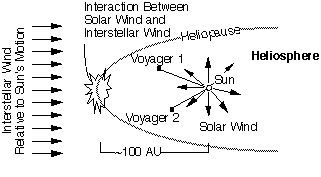
The solar wind can be measured by spacecraft, and it has a large effect on comet tails. It also has a measurable effect on the motion of spacecraft. The speed of the solar wind is about 400 kilometers (250 miles) per second in the vicinity of Earth’s orbit. The point at which the solar wind meets the interstellar medium, which is the “solar” wind from other stars, is called the heliopause. It is a boundary theorized to be roughly circular or teardrop-shaped, marking the edge of the Sun’s influence perhaps 100 AU from the Sun. The space within the boundary of the heliopause, containing the Sun and solar system, is referred to as the heliosphere.
The solar magnetic field extends outward into interplanetary space; it can be measured on Earth and by spacecraft. The solar magnetic field is the dominating magnetic field throughout the interplanetary regions of the solar system, except in the immediate environment of planets which have their own magnetic fields.
 The Terrestrial Planets
The Terrestrial Planets
The terrestrial planets are the four innermost planets in the solar system, Mercury, Venus, Earth and Mars. They are called terrestrial because they have a compact, rocky surface like the Earth’s. The planets, Venus, Earth, and Mars have significant atmospheres while Mercury has almost none. The following diagram shows the approximate distance of the terrestrial planets to the Sun.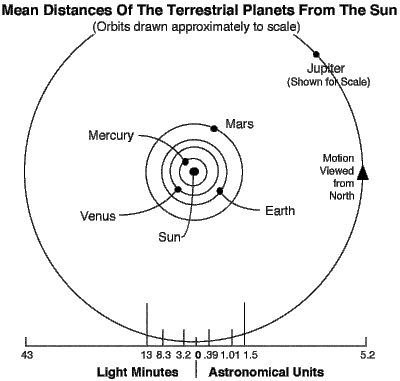
The Jovian Planets
Jupiter, Saturn, Uranus, and Neptune are known as the Jovian (Jupiter-like) planets, because they are all gigantic compared with Earth, and they have a gaseous nature like Jupiter’s. The Jovian planets are also referred to as the gas giants, although some or all of them might have small solid cores. The following diagram shows the approximate distance of the Jovian planets to the Sun.
Our Milkyway Galaxy
This image of our galaxy, the Milky Way, was taken with NASA’s Cosmic Background Explorer’s (COBE) Diffuse Infrared Background Experiment (DIRBE). This never-before-seen view shows the Milky Way from an edge-on perspective with the galactic north pole at the top, the south pole at the bottom and the galactic center at the center. The picture combines images obtained at several near-infrared wavelengths. Stars within our galaxy are the dominant source of light at these wavelengths. Even though our solar system is part of the Milky Way, the view looks distant because most of the light comes from the population of stars that are closer to the galactic center than our own Sun. (Courtesy NASA)
Our Milky Way Gets a Makeover
Like early explorers mapping the continents of our globe, astronomers are busy charting the spiral structure of our galaxy, the Milky Way. Using infrared images from NASA’s Spitzer Space Telescope, scientists have discovered that the Milky Way’s elegant spiral structure is dominated by just two arms wrapping off the ends of a central bar of stars. Previously, our galaxy was thought to possess four major arms.
This artist’s concept illustrates the new view of the Milky Way, along with other findings presented at the 212th American Astronomical Society meeting in St. Louis, Mo. The galaxy’s two major arms (Scutum-Centaurus and Perseus) can be seen attached to the ends of a thick central bar, while the two now-demoted minor arms (Norma and Sagittarius) are less distinct and located between the major arms. The major arms consist of the highest densities of both young and old stars; the minor arms are primarily filled with gas and pockets of star-forming activity.
The artist’s concept also includes a new spiral arm, called the “Far-3 kiloparsec arm,” discovered via a radio-telescope survey of gas in the Milky Way. This arm is shorter than the two major arms and lies along the bar of the galaxy.
Our sun lies near a small, partial arm called the Orion Arm, or Orion Spur, located between the Sagittarius and Perseus arms. (Courtesy NASA/JPL-Caltech)
Spiral Galaxy, NGC 4414
The majestic galaxy, NGC 4414, is located 60 million light-years away. Like the Milky Way, NGC 4414 is a giant spiral-shaped disk of stars, with a bulbous central hub of older yellow and red stars. The outer spiral arms are considerably bluer due to ongoing formation of young, blue stars, the brightest of which can be seen individually at the high resolution provided by the Hubble camera. The arms are also very rich in clouds of interstellar dust, seen as dark patches and streaks silhouetted against the starlight. (Courtesy NASA/STSCI)
Obliquity of the Eight Planets
This illustration shows the obliquity of the eight planets. Obliquity is the angle between a planet’s equatorial plane and its orbital plane. By International Astronomical Union (IAU) convention, a planet’s north pole lies above the ecliptic plane. By this convention, Venus, Uranus, and Pluto have a retrograde rotation or a rotation that is in the opposite direction from the other planets. (Copyright 2008 by Calvin J. Hamilton)
The Solar System
During the past three decades, a myriad of space explorers have escaped the confines of planet Earth and have set out to discover our planetary neighbors. This picture shows the Sun and all nine planets of the solar system as seen by the space explorers. Starting at the top-left corner is the Sun followed by the planets Mercury, Venus, Earth, Mars, Jupiter, Saturn, Uranus, Neptune, and Pluto. (Copyright 1998 by Calvin J. Hamilton)
Sun and Planets
This image shows the Sun and nine planets approximately to scale. The order of these bodies are Sun, Mercury, Venus, Earth, Mars, Jupiter, Saturn, Uranus, Neptune, and Pluto. (Copyright Calvin J. Hamilton)
Jovian Planets
This image shows the Jovian planets Jupiter, Saturn, Uranus and Neptune approximately to scale. The Jovian planets are named because of their gigantic Jupiter-like appearance. (Copyright Calvin J. Hamilton)
The Largest Moons and Smallest Planets
This image shows the relative sizes of the largest moons and the smallest planets in the solarsystem. The largest satellites pictured in this image are: Ganymede (5262 km), Titan (5150 km), Callisto (4806 km), Io (3642 km), the Moon (3476 km), Europa (3138 km), Triton (2706 km), and Titania (1580 km). Both Ganymede and Titan are larger than planet Mercury followed by Io, the Moon, Europa, and Triton which are larger than the planet Pluto. (Copyright Calvin J. Hamilton)
Diagram of Portrait Frames
On February 14, 1990, the cameras of Voyager 1 pointed back toward the Sun and took a series of pictures of the Sun and the planets, making the first ever “portrait” of our solar system as seen from the outside. This image is a diagram of how the frames for the solar system portrait were taken. (Courtesy NASA/JPL)
All Frames from the Family Portrait
This image shows the series of pictures of the Sun and the planets taken on February 14, 1990, for the solar system family portrait as seen from the outside. In the course of taking this mosaic consisting of a total of 60 frames, Voyager 1 made several images of the inner solar system from a distance of approximately 6.4 billion kilometers (4 billion miles) and about 32° above the ecliptic plane. Thirty-nine wide angle frames link together six of the planets of our solar system in this mosaic. Outermost Neptune is 30 times further from the Sun than Earth. Our Sun is seen as the bright object in the center of the circle of frames. The insets show the planets magnified many times. (Courtesy NASA/JPL)
Portrait of the Solar System
These six narrow-angle color images were made from the first ever “portrait” of the solar system taken by Voyager 1, which was more than 6.4 billion kilometers (4 billion miles) from Earth and about 32° above the ecliptic. Mercury is too close to the Sun to be seen. Mars was not detectable by the Voyager cameras due to scattered sunlight in the optics, and Pluto was not included in the mosaic because of its small size and distance from the Sun. These blown-up images, left to right and top to bottom are Venus, Earth, Jupiter, Saturn, Uranus, and Neptune. (Courtesy NASA/JPL)
Sun and Planet Summary
The following table lists statistical information for the Sun and planets:
| Distance (AU) | Radius (Earth’s) | Mass (Earth’s) | Rotation (Earth’s) | # Moons | Orbital Inclination | Orbital Eccentricity | Obliquity | Density (g/cm3) | |
| Sun | 0 | 109 | 332,800 | 25-36* | 9 | — | — | — | 1.410 |
|---|---|---|---|---|---|---|---|---|---|
| Mercury | 0.39 | 0.38 | 0.05 | 58.8 | 0 | 7 | 0.2056 | 0.1° | 5.43 |
| Venus | 0.72 | 0.95 | 0.89 | 244 | 0 | 3.394 | 0.0068 | 177.4° | 5.25 |
| Earth | 1.0 | 1.00 | 1.00 | 1.00 | 1 | 0.000 | 0.0167 | 23.45° | 5.52 |
| Mars | 1.5 | 0.53 | 0.11 | 1.029 | 2 | 1.850 | 0.0934 | 25.19° | 3.95 |
| Jupiter | 5.2 | 11 | 318 | 0.411 | 16 | 1.308 | 0.0483 | 3.12° | 1.33 |
| Saturn | 9.5 | 9 | 95 | 0.428 | 18 | 2.488 | 0.0560 | 26.73° | 0.69 |
| Uranus | 19.2 | 4 | 17 | 0.748 | 15 | 0.774 | 0.0461 | 97.86° | 1.29 |
| Neptune | 30.1 | 4 | 17 | 0.802 | 8 | 1.774 | 0.0097 | 29.56° | 1.64 |
| Pluto | 39.5 | 0.18 | 0.002 | 0.267 | 1 | 17.15 | 0.2482 | 119.6° | 2.03 |
* The Sun’s period of rotation at the surface varies from approximately 25 days at the equator to 36 days at the poles. Deep down, below the convective zone, everything appears to rotate with a period of 27 days.




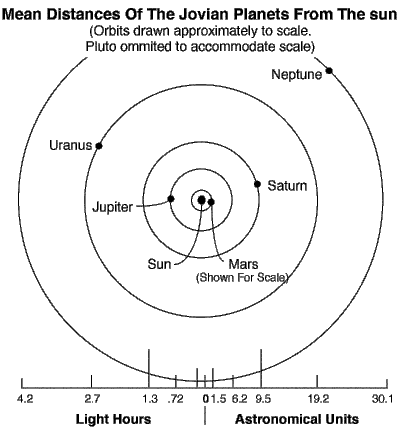
Leave a Reply
You must be logged in to post a comment.